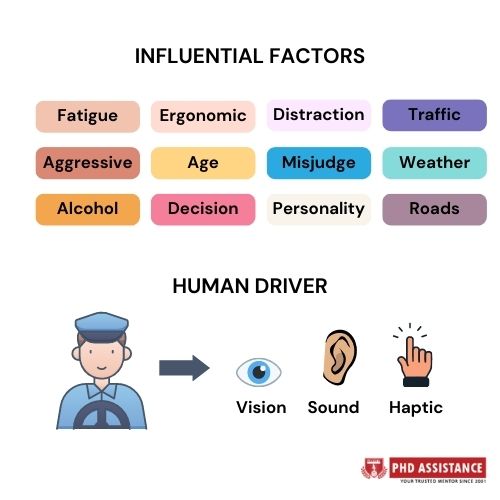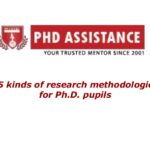Factors Contributing and Counter Measure in Drowsiness Detection of Drivers
Introduction
One of the main factors contributing to traffic accidents is driver drowsiness. According to previous literatures, drowsy driving accounts for 25 to 30% of all traffic accidents. As a result, many people lose their lives and a great deal of property is harmed, and these statistics rise daily. A state of the sleep-wake cycle called drowsiness, sometimes known as sleepiness, occurs when a person feels the urge to sleep. According to recent analytics by the National Highway Traffic Safety Administration (NHTSA), sleepy driving is thought to be the primary factor in 56,000 traffic accidents that occur each year in the United States and result in 40,000 injuries and 1,550 fatalities (Biswal et al., 2021).
Creating a system that can accurately identify tiredness and prevent accidents on the road will take a lot of work. The development of intelligent automobiles to avoid such accidents has made some progress. The creation of reliable and useful technologies for Drowsiness detection has become increasingly important as interest in intelligent cars grows (Ozturk et al., 2022). Below are the three major factors for Driver drowsiness detection.
Drowsiness and Fatigue
Fatigue has been divided into physical or muscle exhaustion and mental fatigue in the study of (Dallaway et al., 2022). Physical effort over an extended period of time, such as during physical activity or when performing duties that require physical labour, can result in physical tiredness. It is unclear what specifically causes mental tiredness. Hu & Lodewijks (2021) states that a subtly manifested state of being mentally exhausted results in a lack of motivation to carry out any task. According to past literatures, sleepiness is the sensation of having difficulty staying awake, whereas fatigue is a depiction of exhaustion. Tasks that must be completed continuously cause aversion toward the action and eventually reduce one’s ability to do the work.
Fatigue is a phenomenon that refers to this growing unwillingness. But tiredness may also be brought on by sleep-related factors, such as how much sleep was had recently, how well it was slept, and how long you were up. Mélan & Cascino (2022) makes the point that works, including workload and work period, can cause exhaustion in addition to sleep (sleep deprivation and time of last sleep). Sleep variables have an impact on both sleep-related exhaustion and sleepiness, which are both utilised in driving episodes alternatively.
Figure 1: Influential Factors

Drowsiness Countermeasures
The behaviour that drivers have adopted to overcome tiredness in a sleepy condition is called a Drowsiness countermeasure. The most popular countermeasures include: pausing for a brief break to eat, relax, or snooze; drinking coffee or energy drinks; cleaning one’s face; altering the ventilation or airflow; smoking; distracting oneself by gazing around; switching the driver; and listening to music or the radio (Kang et al., 2022). Although these activities have been recognised as the primary causes of distraction while driving, additional well-known remedies include requesting the co-passenger to initiate the conversation and messaging or making a phone call. In addition to the driver-initiated safety features, there are rumble strips that begin vibrating anytime a car runs off the road or swerves in and out of a lane.
According to (Cori et al., 2021), stopping night-time and/or extended driving can significantly lower traffic accidents on their own. A further way to improve road safety is by offering potential therapy to drivers who are afflicted with different sleep disorders. The vehicle-based drowsiness detection method performs well in controlled environments, such as driving simulators, but it may prove ineffective in real-world circumstances if certain driving behaviours, such as frequently changing lanes or weaving in and out of traffic, deviate from their baseline values (Al-madani et al., 2021).
Additionally, new image processing methods—which are extremely sensitive to variations in lighting—are needed for behavioural evaluation. Additionally, poor image quality may be caused by insufficient background-foreground lighting, which includes illumination from drivers’ sunglasses or eyeglasses, motion of the drivers, and passing vehicle speed.
Factors Contributing Drowsiness
The circadian rhythm, age, physical fitness, alcohol use, work-related factors including noise and temperature in the car, driving schedule, and road conditions like monotony, car density, and lane density are all factors that might contribute to tiredness (Hu & Lodewijks, 2021). It has been noted that persons who are in harmony with their circadian rhythm frequently experience sleepiness between the hours of 1:00 and 6:00 on any given day. Additionally, driving at night raises the risk factor to around three to six times that of driving during the day since it is more likely for people to fall asleep and their vision is impaired (Rajkar et al., 2022).
When contrasted to any other contextual elements, it has been found that repetitive driving has a significant negative influence on the driver’s attentional stimulation and quickly promotes sleepiness. Drivers sometimes don’t recognise when they are drowsy, which may be dangerous. Drivers who fall asleep behind the wheel become less aware of their surroundings and have slower reaction times. Additionally, being sleepy makes it harder for drivers to make decisions (Jose et al., 2021).
Summary
Thus driver drowsiness levels may be detected more precisely and consistently using physiological signs in recent times. The process of gathering the driver’s bio signal, evaluating it to determine the driver’s condition, and lastly sending out the alarm must be quick enough for the detection system to provide an alert (early warning sign) before any accident happens.
At PhD assisatnce, our professional experts who are specialized in all domain like computer science engineering (machine learning, artificial intelligence) will provide a top-notch PhD dissertation writing services from scratch.
References
Al-madani, A.M., Gaikwad, A.T., Mahale, V., Ahmed, Z.A.T. & Shareef, A.A.A. (2021). Real-time Driver Drowsiness Detection based on Eye Movement and Yawning using Facial Landmark. In: 2021 International Conference on Computer Communication and Informatics (ICCCI). 27 January 2021, IEEE, pp. 1–4. DOI: 10.1109/ICCCI50826.2021.9457005.
Assistance, P. (2021). Drowsiness Detection among Drivers to Prevent Accidents. 2021.
Biswal, A.K., Singh, D., Pattanayak, B.K., Samanta, D. & Yang, M.-H. (2021). IoT-Based Smart Alert System for Drowsy Driver Detection C.-M. Chen (ed.). Wireless Communications and Mobile Computing, 2021. pp. 1–13. DOI: 10.1155/2021/6627217.
Cori, J.M., Manousakis, J.E., Koppel, S., Ferguson, S.A., Sargent, C., Howard, M.E. & Anderson, C. (2021). An evaluation and comparison of commercial driver sleepiness detection technology: a rapid review. Physiological measurement, 42 (7). pp. 74007.
Dallaway, N., Lucas, S.J.E. & Ring, C. (2022). Cognitive tasks elicit mental fatigue and impair subsequent physical task endurance: Effects of task duration and type. Psychophysiology, 59 (12). DOI: 10.1111/psyp.14126.
Hu, X. & Lodewijks, G. (2021). Exploration of the effects of task-related fatigue on eye-motion features and its value in improving driver fatigue-related technology. Transportation Research Part F: Traffic Psychology and Behaviour, 80. pp. 150–171. DOI: 10.1016/j.trf.2021.03.014.
Jose, J., Vimali, J.S., Ajitha, P., Gowri, S., Sivasangari, A. & Jinila, B. (2021). Drowsiness Detection System for Drivers Using Image Processing Technique. In: 2021 5th International Conference on Trends in Electronics and Informatics (ICOEI). 3 June 2021, IEEE, pp. 1527–1530. DOI: 10.1109/ICOEI51242.2021.9452864.
Kang, N., Han, S., Kim, S., Kwon, S., Choi, Y., Lee, Y.-T. & Lee, S.-I. (2022). Driver Drowsiness Detection based on 3D Convolution Neural Network with Optimized Window Size. In: 2022 13th International Conference on Information and Communication Technology Convergence (ICTC). 19 October 2022, IEEE, pp. 425–428. DOI: 10.1109/ICTC55196.2022.9952988.
Mélan, C. & Cascino, N. (2022). Effects of a modified shift work organization and traffic load on air traffic controllers’ sleep and alertness during work and non-work activities. Applied Ergonomics, 98. pp. 103596. DOI: 10.1016/j.apergo.2021.103596.
Ozturk, M., Kucukmani Sa, A. & Urhan, O. uzhan (2022). Drowsiness detection system based on machine learning using eye state. Balkan journal of electrical and computer engineering, 10 (3). pp. 258–263.
Rajkar, A., Kulkarni, N. & Raut, A. (2022). Driver Drowsiness Detection Using Deep Learning. In: Applied Information Processing Systems. Springer, pp. 73–82.
 Previous Post
Previous Post Next Post
Next Post
